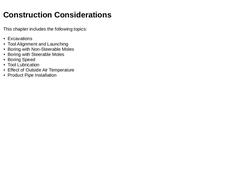
|
|

|
Impact moling jobs are generally small projects that do not involve formal bidding. Public agencies either have their own crews equipped with impact moles to perform installation of new residential service lines, or they engage independent contractors on general contracts. Bidding associated with impact moling principally involves the purchase of an impact mole. Some guidance on bid criteria for impact mole purchasing is provided below. |

|
(Image: Two-stage moving head action without pre-tensioned steel spring (Vermeer)) The latest advancement in the moving head design has eliminated the pre-tensioned steel spring from the mole body. Figure 8 shows the two-stage action of this type of moving head. In the first stage, as compressed air propels the piston hitting the rear of the chisel, the gap between the head and the body in the tool opens. In the second stage, as the piston hits front … |
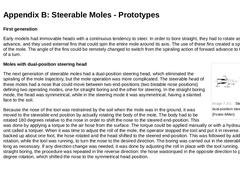
|
First generation Early models had immovable heads with a continuous tendency to steer. In order to bore straight, they had to rotate as they advance, and they used external fins that could spin the entire mole around its axis. The use of these fins created a spiral trajectory of the mole. The angle of the fins could be remotely changed to switch from the spiraling action of forward advance to the execution of a turn. (Image: Steerable mole with dual-… |
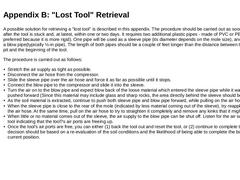
|
A possible solution for retrieving a "lost tool" is described in this appendix. The procedure should be carried out as soon as possible after the tool is stuck and, at latest, within one or two days. It requires two additional plastic pipes - made of PVC or PE pipe (PVC is preferred because it is more rigid). One pipe will be used as a sleeve pipe (its diameter depends on the mole size), and the other as a blow pipe(typically ½-in pipe). The length … |

|
|

|
|

|

(Image: 386321 - Titelbild Dokumentation) Process: Lateral connection repair Title: Recovery of lateral connections DN 150 of a sewer DN 250 that was rehabilitated by CIPP using the DrainLCR system Location: Factory premises Limiting conditions:
- System: mixed water
- Material: vitrified clay / plastic
- Nominal size: sewer DN 200 / 250 / 300
lateral DN 150
- gradient: 1‰
- depth position: approx. 0.6 m (≈ 2ft.)
- rehabilitation length: 100 m (≈ 328 ft.), …
|

|

Description of the system With the DrainLCR-Liner system the region of the lateral connection is rehabilitated starting from the main sewer up to 300 mm (≈ 12 in.) into the lateral by using a hat-shaped connection sleeve. A packer with a lifting mechanism with compressed air cylinder, which is mounted onto its packer rod below the calibration hose, serves for positioning. Under integrated camera supervision, the LCR packer is pushed behind the connection … |
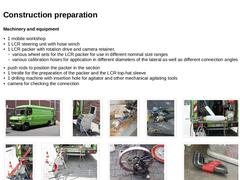
|

Machinery and equipment - 1 mobile workshop
- 1 LCR steering unit with hose winch
- 1 LCR packer with rotation drive and camera retainer,
- various wheel sets for the LCR packer for use in different nominal size ranges
- various calibration hoses for application in different diameters of the lateral as well as different connection angles
- push rods to position the packer in the section
- 1 trestle for the preparation of the packer and the LCR top-hat sleeve
- 1 …
|
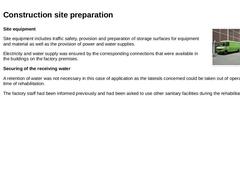
|

(Image: Arrangement of the construction site) Site equipment Site equipment includes traffic safety, provision and preparation of storage surfaces for equipment and material as well as the provision of power and water supplies. Electricity and water supply was ensured by the corresponding connections that were available in the buildings on the factory premises. Securing of the receiving water A retention of water was not necessary in this case of application … |

|

Rehabilitation main sewer In the run-up to the project, the main sewer was rehabilitated by the CIPP (cured-in-place pipe) method and the lateral connections were milled open by a sewer robot. Inspection and documentation Before recovering the lateral connections, the sewer is once again inspected and the connections are examined. (Image: View inside a defective connection) Preparation of the manhole Due to the low positional depth of the sewer, it was … |

|

First, a lateral that leads into the main sewer at an angle of 45° is connected. Preparation of the packer For preparation in a first working step form oil is applied onto the packer, which is equipped with a slightly erected and cleaned calibration hose. A guiding wire is fixed to the end of the balloon of the calibration hose. It is intended to ease the later application of the impregnated top-hat sleeve onto the packer. | (Image: Cleaned and erected … |
|

|

Installation of the top-hat sleeve During the installation of the packer, one member of staff is needed to operate the control unit and another one at the manhole to position the packer by means of the push rods. Important: When transporting the packer to the manhole, care must be taken of the fact that the calibration hose is not damaged. The packer is inserted into the sewer that is to be rehabilitated via the manhole. Before connecting the LCR packer … |

|

At the end the lateral connection is inspected optically by using a push rod camera. | (Image: Push rod camera) | (Image: DrainLCR-System - rehabilitated lateral connection) | (Image: DrainLCR-System - rehabilitated lateral connection) |
|

|

Next a lateral, which leads into the main sewer at an angle of 90°, has to be connected. For this purpose, the calibration hose and the packer basket must be replaced. Demounting of the calibration hose In the first working step the connection clamps are removed from both ends of the packer, the LCR string of the pulling-in suite for the balloon of the calibration hose inside the packer is cut and the lid of the winding box is screwed open to remove … |

|

Now, the lateral that leads into the main sewer at an angle of 90° is connected. The rehabilitation process is the same as the rehabilitation process with top-hat sleeves at a connection angle of 45°. It includes: Preparation of the packer - Dabbing the calibration hose with form oil
- Fixing the guiding wire to the balloon of the calibration hose
| (Image: Dabbing the packer with form oil) | (Image: Guiding wire at the end of the balloon of the calibration … |
|

|

Repairing the connection of DN 150 lateral sewers connected to a DN 250 sewer by means of cured-in-place top hat profile (DrainLCR system) (CIPP). |
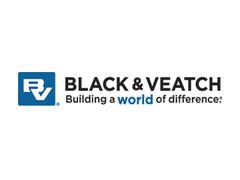
|
Jun 27, 2019
News
Christopher Clark
As climate change carries increasingly varied challenges of both too little and too much water, cities and utilities are renewing their focus on reuse strategies to ensure a safe and resilient supply. Black & Veatch announced the addition of water reuse expert Jo Ann Jackson as One Water Planning Practice Leader in the global construction, engineering, and consulting company’s Water Planning Group.
|

|
Aug 09, 2022
News
Dr. Carsten Fischer
For the rehabilitation of a drinking water pipeline in the district of Aalen, 200 km north-east of Munich, Germany, the DENSO Group Germany protects weld seams from corrosion very quickly and efficiently using a new laying method that floats in water.
|

|
This report was prepared by the Trenchless Technology Center (TTC) for the U.S. Army Corps of Engineers, Engineering Research and Development Center (ERDC). Neither TTC, the U.S. Army Corps of Engineers, nor any person acting on their behalf, makes a warranty, express or implied, with respect to the use of any information, apparatus, method, or process disclosed in this report or that such use may not infringe on privately owned rights; or assumes … |

|
Although pipe bursting is an established and widely used trenchless method for renewal of gas, water and sewer pipelines, it is not covered adequately with guidelines and standards. The need for guidelines in this area was demonstrated in a study Identification of Needs for User Guidance in Trenchless Technology Applicatiosn, which was prepared by the Waterways Experiment Station (WES) (now Engineering Research and Development Center - ERDC) with … |

|
Pipe bursting is a well-established method for trenchless replacement of worn out and undersized gas, water and sewer pipes. An existing pipe is replaced size-for-size or up-sized with a new pipe in the same location. The technique is the most cost effective when there are few lateral connections, when the old pipe is structurally deteriorated, and when additional capacity is needed. Pipe bursting, which can be either pneumatic, hydraulic expansion … |

|
In a typical pipe bursting operation, a cone-shaped tool ("bursting head") is inserted into the existing pipe and forced through it, fracturing the pipe and pushing its fragments into the surrounding soil. At the same time, a new pipe is either pulled or pushed in the annulus left by the expanding operation (depending on the type of the new pipe). In the vast majority of pipe bursting operations, the new pipe is pulled into place. The new pipe can … |

|
|
(Image: Bursting head of the pneumatic system [Sterl01])
|
|
(Image: Bursting head of the pneumatic system)
|
Pneumatic pipe bursting is the most frequently used type of pipe bursting to date. It is used on the majority of pipe bursting projects worldwide [Howel99] In the pneumatic pipe bursting, the bursting head is a cone-shaped soil displacement hammer. It is driven by compressed air, and operated at a rate of 180 to 580 blows /minute. The percussive … |